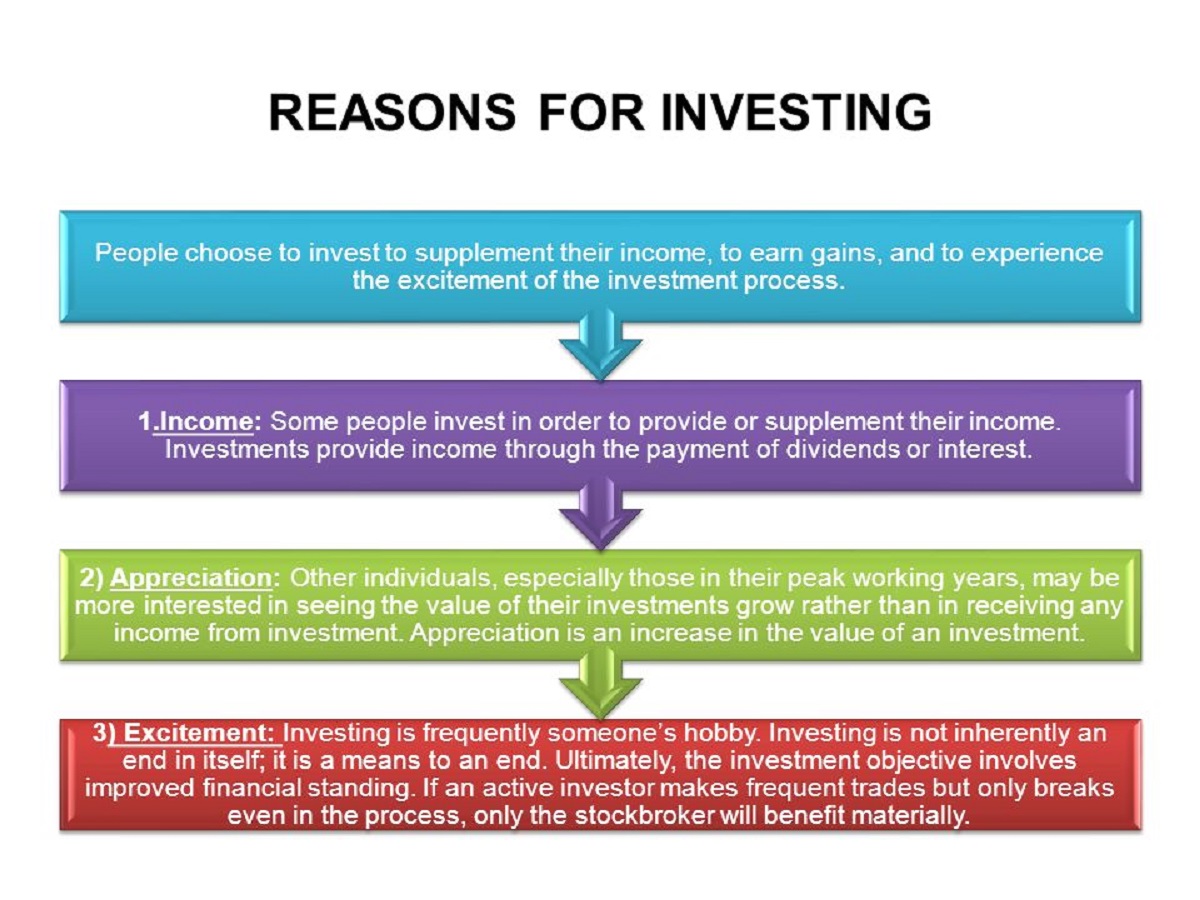Introduction
Investing in stocks can be both exciting and intimidating. The stock market offers the potential for significant capital gains, but it also comes with the risk of capital losses. Understanding why investments in stocks can result in both gains and losses is essential for anyone looking to build a successful investment portfolio.
Stocks, also known as shares or equities, represent ownership in a company. When you invest in stocks, you are essentially buying a piece of that company. The value of your investment fluctuates as the stock price goes up or down.
There are several factors that influence stock prices and ultimately lead to capital gains or losses. Economic factors, such as interest rates, inflation rates, and GDP growth, can have a significant impact on stock prices. When the economy is thriving, companies tend to perform well, leading to higher stock prices and capital gains. Conversely, during an economic downturn, stock prices may decline, resulting in capital losses.
Company performance is another crucial factor to consider. Strong earnings growth, innovative products or services, and effective management can drive up stock prices and generate capital gains. On the other hand, poor financial performance or negative news can cause stock prices to plummet, leading to capital losses.
Industry trends also play a role in determining stock prices. Rapidly growing industries, such as technology or renewable energy, are more likely to experience higher stock prices and capital gains. Conversely, companies in declining industries may face stock price declines and capital losses.
News and market sentiment can have a significant impact on stock prices as well. Positive news about a company, such as a new product launch or a major contract, can boost stock prices and result in capital gains. Conversely, negative news, such as a lawsuit or a scandal, can cause stock prices to plummet and lead to capital losses.
The laws of supply and demand also affect stock prices. If there is high demand for a particular stock and limited supply, the stock price is likely to increase, resulting in capital gains. Conversely, if there is a surplus of stocks available and low demand, the stock price may decline, causing capital losses.
Earnings reports are closely watched by investors as they provide insights into a company’s financial health and future prospects. Strong earnings growth can drive stock prices up, while disappointing earnings can lead to stock price declines and capital losses.
Dividends, which are payments made by companies to shareholders, can also impact stock prices. When a company pays a dividend, it is a sign of profitability and can attract investors, leading to higher stock prices and potential capital gains. Conversely, if a company cuts or eliminates its dividend, it may result in stock price declines and capital losses.
What Are Stocks?
Stocks, also known as shares or equities, are financial instruments that represent ownership in a company. When individuals or institutions buy stocks, they are essentially purchasing a portion of ownership in that particular company.
Stocks are typically issued by publicly traded companies, which means they are available for purchase on stock exchanges. These exchanges facilitate the buying and selling of stocks, allowing investors to trade their shares with other investors.
When an individual owns stocks in a company, they become partial shareholders. This means they have a claim on the company’s assets and earnings, as well as the right to vote on certain company decisions. The number of shares an investor owns determines their ownership stake in the company.
Stocks can be classified into different types, such as common stock and preferred stock. Common stock represents the majority of stocks available and gives shareholders voting rights in the company. Preferred stock, on the other hand, usually does not provide voting rights but offers preferential treatment when it comes to dividend payments and liquidation.
The value of stocks can change on a daily basis due to various factors, such as market conditions and company performance. When the price of a stock increases, it is said to have gained value, resulting in capital gains for the investors. Conversely, if the stock price drops, it leads to capital losses.
Investing in stocks offers individuals the opportunity to participate in the growth and success of companies. By purchasing stocks, investors have the potential to earn returns through capital appreciation (the increase in stock price) and dividends.
It is important to note that investing in stocks comes with risks. The stock market can be volatile, and the value of stocks can fluctuate significantly in a short period. This means that investors could experience both gains and losses, depending on market conditions and their investment decisions.
Overall, stocks play a crucial role in the financial markets, providing individuals and institutions with a means to invest in companies and potentially profit from their growth and success. Understanding the fundamentals of stocks is essential for anyone looking to venture into the world of investing and make informed decisions about their portfolio.
How Investments in Stocks Work
Investing in stocks involves purchasing shares of a company with the expectation of earning a return on that investment. When you invest in stocks, you become a partial owner of the company and have the potential to benefit from its growth and success.
Here’s how investments in stocks work:
1. Selecting a Stock: The first step is to research and choose the stocks you want to invest in. This involves evaluating the company’s financial health, industry trends, and growth prospects. It’s important to conduct thorough research and consider factors such as the company’s revenue, earnings, debt levels, competitive advantages, and management team.
2. Placing an Order: Once you have selected a stock, you need to place an order to buy the shares. This can be done through a brokerage account or an online trading platform. You specify the number of shares you want to buy and the price at which you are willing to buy them.
3. Executing the Trade: When your buy order is matched with a sell order from another investor, the trade is executed. This means that you now officially own the shares of the company you invested in. The transaction is typically settled within a few days.
4. Monitoring Your Investment: After purchasing stocks, it’s important to keep an eye on your investment. Stay informed about the company’s performance, industry news, and market trends. Regularly review your portfolio and make adjustments if necessary.
5. Earning Returns: There are two main ways investors can earn returns from their investments in stocks:
- Capital Gains: If the price of the stock increases, you can sell your shares at a profit, resulting in capital gains. This is the most common way investors make money in the stock market. However, it’s important to note that the stock price can also decline, leading to potential capital losses.
- Dividends: Some companies distribute a portion of their profits to shareholders in the form of dividends. Dividends are typically paid out on a regular basis, such as quarterly or annually. They provide investors with a steady income stream and can contribute to overall investment returns.
6. Diversification: Investing in a single stock can be risky because if that company performs poorly, you could face significant losses. Diversification involves spreading your investments across different stocks, industries, and asset classes. This helps to reduce the impact of any single investment on your overall portfolio and mitigate risks.
It’s important to note that investing in stocks comes with risks, including the potential for loss of capital. Stock prices can be influenced by various factors such as market conditions, economic events, and company-specific news. It’s essential to carefully research your investment choices, set realistic expectations, and seek professional advice if needed.
By understanding how investments in stocks work and adopting a disciplined and informed approach, investors can potentially achieve their financial goals and build long-term wealth.
The Factors that Influence Stock Prices
Stock prices are constantly changing, driven by various factors in the financial markets. Understanding the factors that influence stock prices is crucial for investors to make informed decisions and navigate the complexities of the stock market. Here are some key factors that can impact stock prices:
Economic Factors: Economic conditions play a significant role in determining stock prices. Factors such as interest rates, inflation rates, and GDP growth can impact investor sentiment and drive stock prices up or down. In a growing economy with low interest rates and low inflation, companies tend to perform well, leading to higher stock prices. Conversely, in a recession or an environment of high interest rates and inflation, stock prices may decline.
Company Performance: The financial performance of a company directly influences its stock price. Factors such as revenue growth, earnings, profit margins, and cash flow are key indicators of a company’s performance. Positive earnings surprises or strong growth prospects can boost investor confidence and result in higher stock prices. Conversely, poor financial performance or negative news can cause stock prices to decline.
Industry Trends: The performance of specific industries can impact the stock prices of companies within those industries. Industries experiencing rapid growth, high demand, or technological advancements are more likely to have higher stock prices. On the other hand, industries facing challenges, regulatory changes, or disruptive technologies may see declines in stock prices.
News and Market Sentiment: News about a company, industry, or the overall market can significantly influence stock prices. Positive news, such as new product launches, mergers and acquisitions, or strong earnings reports, can drive stock prices up. Conversely, negative news, such as lawsuits, scandals, or economic uncertainty, may cause stock prices to decline. Market sentiment, which refers to the overall attitude of investors towards the market, can also impact stock prices. Optimism or pessimism among investors can lead to buying or selling activity, influencing stock prices.
Supply and Demand: The principles of supply and demand apply to the stock market as well. If there is high demand for a particular stock and limited supply, the stock price is likely to increase. Conversely, if there is a surplus of stocks available and low demand, the stock price may decline. Factors such as investor interest, market liquidity, and institutional buying or selling can influence supply and demand dynamics.
Earnings Reports: Quarterly or annual earnings reports released by companies can have a significant impact on stock prices. Investors closely monitor these reports to assess a company’s financial health, growth prospects, and overall performance. Positive earnings surprises or strong guidance for future earnings can lead to stock price increases. Conversely, disappointing earnings or lower-than-expected guidance can cause stock prices to decline.
Dividends: Dividends are payments made by companies to shareholders as a portion of their profits. Dividends can impact stock prices, as they attract investors seeking regular income. Companies that consistently pay dividends and increase their dividend payments over time are often viewed favorably by investors, leading to higher stock prices. On the other hand, if a company cuts or eliminates its dividend, it may negatively impact its stock price.
Understanding these factors can help investors make more informed decisions and navigate the stock market. It is important to note that various factors can interact and influence stock prices simultaneously. Monitoring and analyzing these factors, along with conducting thorough research, can contribute to successful investing in the stock market.
Economic Factors
Economic factors play a significant role in influencing stock prices. The overall health and performance of the economy can impact investor sentiment, leading to fluctuations in stock prices. Understanding the interplay between economic factors and stock markets can help investors make informed decisions. Here are some key economic factors that influence stock prices:
Interest Rates: Changes in interest rates have a direct impact on stock prices. When interest rates are low, borrowing costs decrease, making it cheaper for companies to finance their operations and invest in growth opportunities. This can lead to higher stock prices as investors anticipate increased profitability. Conversely, when interest rates rise, borrowing becomes costlier, which can reduce corporate profits and dampen investor optimism, potentially resulting in lower stock prices.
Inflation: Inflation, the increase in the general level of prices over time, can affect purchasing power and investor confidence. When inflation is high, the value of money decreases, potentially eroding future returns on investments. In response, investors may seek to invest in assets that can outpace inflation, such as stocks. As demand for stocks increases, stock prices tend to rise. Conversely, when inflation is low or deflationary pressures exist, investors may seek safer assets, leading to lower stock prices.
Gross Domestic Product (GDP) Growth: GDP growth is a key indicator of economic performance. When GDP is growing, it signifies a healthy economy, with more goods and services being produced and consumed. Strong GDP growth can boost corporate earnings and drive investor confidence, resulting in higher stock prices. However, if GDP growth slows down or contracts, it can signal economic weakness, potentially causing stock prices to decline.
Unemployment Rates: Low unemployment rates are generally associated with a strong economy, as they indicate higher levels of consumption and economic activity. When unemployment rates are low, companies may experience increased demand for their products or services, leading to higher revenues and potentially driving up stock prices. Conversely, rising unemployment rates can signal economic challenges, reducing consumer spending and company profitability, which may result in lower stock prices.
Consumer Confidence: Consumer confidence is a measure of consumers’ optimism or pessimism about the state of the economy. High consumer confidence levels indicate a positive outlook, leading to increased consumer spending and business growth. This can contribute to higher stock prices as investors anticipate higher corporate profits. Conversely, low consumer confidence can lead to reduced spending and slower business growth, which may negatively impact stock prices.
Government Policies: Government policies, such as fiscal and monetary measures, can have a significant impact on the economy and stock market. Fiscal policies, such as tax rates and government spending, can influence consumer and business behavior, affecting corporate profitability and stock prices. Monetary policies, including interest rates and money supply, set by central banks, can impact borrowing costs, inflation, and overall market liquidity, influencing investor sentiment and stock prices.
It is important to note that economic factors do not operate in isolation, and their impact on stock prices can be complex and interconnected. Moreover, economic conditions can vary across different regions and industries, leading to diverse stock market performance. Monitoring economic indicators and their potential impact on stock prices can help investors make better-informed investment decisions and manage their portfolios effectively.
Company Performance
Company performance plays a fundamental role in determining stock prices. The financial health, growth prospects, and overall management of a company influence investor sentiment and, consequently, stock prices. Understanding the key factors that contribute to company performance can help investors evaluate the potential for capital gains or losses. Here are some important aspects of company performance that impact stock prices:
Revenue Growth: The growth of a company’s revenue is a critical indicator of its performance. Increasing revenue suggests that the company’s products or services are in demand, leading to higher sales and potential profitability. Companies that consistently demonstrate strong revenue growth are often viewed favorably by investors, contributing to higher stock prices.
Earnings and Profitability: Earnings represent a company’s profits after deducting expenses, taxes, and interest. Positive earnings growth is a key driver of stock prices. When a company consistently generates higher earnings, it indicates strong financial performance and the potential for increased shareholder value. Higher profits can result from factors such as cost management, increased market share, or successful product launches.
Profit Margins: Profit margins measure the efficiency of a company’s operations and its ability to generate profits from sales. Higher profit margins indicate effective cost management or the ability to command premium prices for products or services. Companies with wider profit margins tend to be more attractive to investors, leading to higher stock prices.
Cash Flow: Cash flow reflects the money coming in and going out of a company’s operations. Positive cash flow indicates that a company has sufficient liquidity to meet its financial obligations, invest in growth opportunities, and potentially reward shareholders. Companies with strong and consistent cash flow are often perceived as financially stable, increasing investor confidence and contributing to higher stock prices.
Competitive Advantages: Companies with competitive advantages have unique qualities that set them apart from their competitors. These advantages could be patents, strong brand recognition, distribution networks, or proprietary technology. Having a competitive edge can result in increased market share, higher profits, and potential stock price appreciation as investors recognize the company’s ability to outperform its peers.
Management Team: The leadership and expertise of a company’s management team have a significant impact on its performance and stock prices. A capable management team can make sound strategic decisions, drive innovation, efficiently allocate resources, and navigate the challenges of the business landscape. Companies with strong leadership are often viewed more favorably by investors, leading to higher stock prices.
Product and Market Innovation: Companies that introduce innovative products or services or successfully enter new markets often experience growth in sales and profitability. Innovation can drive customer demand, increase market share, and enhance competitiveness. Investors recognize the potential for future growth and reward companies with higher stock prices.
It is important for investors to carefully analyze a company’s performance by evaluating financial statements, industry trends, and competitive landscape. A comprehensive understanding of a company’s performance can help investors make informed investment decisions and identify potential opportunities for capital gains.
Industry Trends
Examining industry trends is essential for understanding the dynamics of specific sectors and their potential impact on stock prices. Industries are not homogenous, and factors such as technological advancements, consumer preferences, and market conditions can significantly influence stock prices within a given sector. Here are some key aspects of industry trends that impact stock prices:
Growth Potential: Industries with high growth potential often attract investor attention, leading to higher stock prices. Industries experiencing rapid expansion, driven by factors such as rising demand, technological innovation, or favorable regulatory environments, are more likely to see increases in stock prices. Companies operating in these industries have a greater chance of generating higher revenues and profits, driving investor optimism.
Market Saturation or Decline: Industries that have reached a saturation point or are facing decline may experience downward pressure on stock prices. Saturated markets have limited room for growth, making it challenging for companies to generate significant increases in sales or profits. Declining industries face challenges such as changing consumer preferences, outdated technologies, or disruptive competitors, which can result in lower stock prices as investors anticipate reduced profitability.
Technological Advancements: Technological advancements can have a profound impact on industries and their stock prices. Industries that embrace and adapt to new technologies are more likely to thrive, as they can increase efficiency, enhance productivity, and lead to innovative products or services. Investors recognize the potential of companies at the forefront of technological advancements, resulting in higher stock prices.
Regulatory Environment: The regulatory environment can significantly influence industry dynamics and stock prices. Changes in government regulations, such as tax policies, environmental regulations, or industry-specific regulations, can impact company profitability and investor sentiment. Favorable regulations can lead to increased investor confidence and higher stock prices, while unfavorable regulations may lead to lower stock prices as investors anticipate reduced profitability.
Consumer Preferences and Demographics: Shifting consumer preferences and demographics play a role in shaping industry trends and stock prices. Industries that align with changing consumer demands, such as those related to sustainability, health, or convenience, are more likely to experience positive stock price movements. Companies adapting their products or services to meet evolving consumer preferences have a better chance of attracting customers and generating higher revenues, which can drive stock prices upward.
Competitive Landscape: The competitive landscape within an industry can impact stock prices. Industries with intense competition and a fragmented market may experience downward pressure on stock prices as companies compete for market share and profits. Conversely, industries with more consolidated market structures or companies with dominant market positions may have higher stock prices as investors perceive them as having a competitive advantage.
Industry Disruptors: Disruptive technologies or business models can have a profound impact on industries and stock prices. Companies that introduce disruptive innovations can gain a significant competitive advantage, often leading to higher stock prices. Conversely, established companies that fail to adapt to disruptions and changing industry dynamics may experience declines in stock prices as investors anticipate reduced market relevance or even obsolescence.
Analysing industry trends is a critical aspect of determining the potential for capital gains or losses in a stock portfolio. By understanding the current and future dynamics of specific industries, investors can make informed decisions and adapt their investment strategies accordingly.
News and Market Sentiment
News and market sentiment are significant factors that influence stock prices. Investors closely monitor news about companies, industries, and the overall market, as it can have a substantial impact on investor sentiment and subsequently drive stock prices up or down. Understanding the role of news and market sentiment can help investors navigate the stock market more effectively. Here are the key aspects to consider:
Positive News: Positive news about a company, such as strong earnings reports, new product launches, or successful partnerships, can drive stock prices higher. Positive news indicates that a company is performing well and has the potential for future growth. Investors tend to react positively to such news, increasing demand for the company’s stock and resulting in price appreciation.
Negative News: Negative news, such as lawsuits, accidents, product recalls, or financial scandals, can have a detrimental effect on stock prices. Negative news erodes investor confidence and raises concerns about the company’s financial health and prospects. Investors may sell off their shares, leading to a decline in stock prices. Negative news impacting an entire industry or the broader market can also cause a ripple effect, affecting multiple stocks.
Earnings Reports: Earnings reports provide essential insights into a company’s financial performance and are closely monitored by investors. Strong earnings growth, exceeding analysts’ expectations, can lead to stock price increases. Conversely, disappointing earnings or lower-than-expected guidance may result in stock price declines. Investors rely on earnings reports to assess a company’s profitability, liquidity, and overall financial health.
Market Sentiment: Market sentiment refers to the overall attitude or sentiment of investors towards the stock market. It often reflects perceptions of general economic conditions, geopolitical events, or market trends. Positive market sentiment can lead to increased buying activity, pushing stock prices higher. Conversely, negative market sentiment can drive selling activity, resulting in stock price declines. Market sentiment can be influenced by factors such as global economic indicators, political events, or investor psychology.
Risk Appetite: News and market sentiment can also impact investor risk appetite. During periods of positive news and bullish sentiment, investors may have a higher risk appetite and be more willing to invest in stocks. This increased demand can lead to higher stock prices. Conversely, negative news or bearish sentiment can cause investors to become more risk-averse, seeking safer assets, which can put downward pressure on stock prices.
Market Rumors: Market rumors can have a short-term impact on stock prices. Unverified news or speculation can spread quickly and cause significant price fluctuations. Investors often react to rumors, either buying or selling stocks based on the information. However, it is important for investors to distinguish between factual information and unsubstantiated rumors, as relying solely on rumors can lead to misguided investment decisions.
Monitoring news and market sentiment is crucial for investors. Staying informed about company-specific news, industry trends, and the overall market climate allows investors to make informed decisions regarding their investment portfolios. However, it is essential to conduct thorough research and avoid making impulsive decisions based solely on short-term news or market sentiment.
The Role of Supply and Demand
Supply and demand dynamics play a crucial role in determining stock prices. The interaction between the availability of stocks (supply) and investor interest (demand) drives the buying and selling activity in the stock market. Understanding the role of supply and demand can help investors gauge market sentiment and anticipate potential changes in stock prices. Here are the key aspects to consider:
Market Participants: Stock markets are composed of various market participants, including individual investors, institutional investors, and market makers. The buying or selling decisions of these participants create demand or supply in the market. Institutional investors, such as pension funds or mutual funds, often trade in large volumes and have a significant impact on stock prices due to their substantial holdings.
Scarcity and Abundance: The scarcity or abundance of stocks available for trading directly impacts stock prices. When there is a limited supply of a particular stock and high demand from investors, the price tends to increase as buyers compete for the scarce shares. Conversely, an oversupply of stocks can put downward pressure on stock prices.
Investor Sentiment: Investor sentiment refers to the overall mood or attitude of investors towards the stock market. Positive sentiment, driven by optimism and confidence, leads to increased demand for stocks, driving up prices. Negative sentiment, fueled by pessimism or uncertainty, results in decreased demand, potentially causing stock prices to decline. Investor sentiment is influenced by various factors, such as economic indicators, news, and market trends.
Buyers and Sellers: Stock prices are determined by the interaction of buyers and sellers in the market. When buyers outnumber sellers and are willing to pay higher prices, the demand exceeds the supply, leading to upward price movement. Conversely, if sellers outnumber buyers and are willing to accept lower prices, the supply exceeds the demand, resulting in downward price movement.
Market Liquidity: The availability of buyers and sellers in the market affects liquidity. In liquid markets, there are many participants willing to buy or sell stocks at any given time, which allows for efficient price discovery. High liquidity often leads to narrower bid-ask spreads and smoother transactions. In contrast, illiquid markets have fewer participants, which can lead to wider bid-ask spreads and higher price volatility.
Market Order Flow: The flow of market orders, which are orders to buy or sell stocks at the prevailing market price, impacts stock prices. When there is an imbalance in buy or sell orders, it can influence stock prices significantly. For example, a surge in buy orders can drive stock prices higher due to increased demand, while a surge in sell orders can cause stock prices to decline.
Market Depth: Market depth refers to the level of supply and demand at different price points in the order book. A deep market has substantial buy and sell orders at various price levels, providing ample liquidity. A shallow market, on the other hand, has limited buying or selling interest, which may result in more significant price movements when orders are executed.
Market Manipulation: While less common, market manipulation can impact supply and demand and consequently affect stock prices. Manipulative practices, such as insider trading or pump-and-dump schemes, can create artificial demand or supply, distorting stock prices. Regulators closely monitor and investigate such activities to maintain fair and transparent markets.
Supply and demand dynamics are constantly at play in the stock market, influencing stock prices in real-time. Understanding these dynamics can help investors assess market sentiment, anticipate price movements, and make informed investment decisions.
The Impact of Earnings Reports
Earnings reports are crucial indicators of a company’s financial health and performance. These reports, released by companies on a quarterly or annual basis, provide insights into its revenues, expenses, and profitability. Earnings reports have a significant impact on stock prices as they shape investor expectations and influence market sentiment. Here are the key aspects to consider:
Earnings Surprise: Earnings reports often include the company’s earnings per share (EPS) figure, which represents the company’s profit divided by the number of outstanding shares. If a company’s earnings exceed the market’s expectations, it is considered an earnings surprise. Positive earnings surprises tend to result in stock price increases, as investors perceive them as a sign of strong financial performance and potential future growth.
Earnings Growth: Investors closely examine the earnings growth rate, which measures the percentage increase in earnings compared to a previous period. Higher earnings growth rates are generally considered positive, reflecting a company’s ability to generate increased profits. Companies with consistent earnings growth often receive favorable investor attention, potentially driving stock prices higher.
Revenue Performance: Revenue, or sales, is another vital component of earnings reports. Investors analyze revenue growth rates or changes in revenue year-over-year to assess a company’s ability to generate top-line growth. Companies that report strong revenue growth tend to be viewed more favorably by investors, as it suggests increased customer demand and market share, potentially leading to stock price appreciation.
Profit Margin: Profit margin measures a company’s profitability by measuring the percentage of revenue that remains as profit after accounting for expenses. Investors pay attention to profit margins as they indicate a company’s efficiency in managing costs. Expanding profit margins can lead to higher profitability, driving investor confidence and potentially increasing stock prices.
Guidance and Outlook: Earnings reports often include forward-looking guidance and outlook statements from company management. This guidance provides insights into a company’s expectations for future earnings, revenue growth, and market conditions. Positive guidance or an optimistic outlook can boost investor sentiment and contribute to stock price increases. Conversely, negative guidance or a cautious outlook may lead to declines in stock prices as investors adjust their expectations.
Market Expectations: Earnings reports are compared to market expectations, which are often based on analysts’ forecasts. If a company’s earnings report exceeds analysts’ estimates, it can result in positive market sentiment and potential stock price appreciation. Conversely, if the earnings report falls short of expectations, it can disappoint investors, leading to stock price declines.
Industry and Peer Comparison: Investors also consider how a company’s earnings report compares to its industry peers. Outperformance relative to competitors can boost investor confidence and potentially lead to stock price increases. Conversely, underperformance compared to industry peers may result in lower stock prices as investors reassess the company’s competitiveness and growth prospects.
Long-Term Impact: Earnings reports can have both short-term and long-term impacts on stock prices. In the short term, the immediate reaction to the earnings report can cause significant price movements. However, over the long term, trends in earnings growth and profitability can have a more significant influence on stock prices as investors evaluate the company’s overall performance and potential for sustained success.
Earnings reports provide a snapshot of a company’s financial performance and serve as a critical tool for investors to evaluate investment opportunities. Monitoring and analyzing earnings reports can help investors anticipate potential stock price movements and make informed decisions in the stock market.
The Role of Dividends
Dividends play a significant role in the stock market and can have a substantial impact on stock prices. Dividends are payments made by companies to their shareholders as a distribution of profits. Understanding the role of dividends is crucial for investors, as they provide income and can influence investor sentiment and stock prices. Here are the key aspects to consider:
Income Generation: Dividends are a source of income for investors who hold dividend-paying stocks. Regular dividends provide shareholders with a stream of cash flow, which can supplement other sources of income, such as wages or fixed-income investments. Dividends can be particularly attractive for income-seeking investors, such as retirees or those looking for stable and predictable income streams.
Dividend Yield: Dividend yield is a percentage that represents the annual dividend payment divided by the stock’s current price. Dividend yield is used by investors to assess the attractiveness of dividend-paying stocks. Higher dividend yields are generally perceived as more favorable, indicating a higher return on investment through dividends. Investors often compare dividend yields across different stocks and industries to make informed investment decisions.
Investor Confidence: Companies that consistently pay dividends are often viewed favorably by investors. Dividends are a sign of profitability and financial stability, demonstrating that a company generates sufficient earnings to return a portion to shareholders. Consistently paying dividends can enhance investor confidence and positively impact stock prices as investors perceive the company as being well-managed and dependable.
Dividend Growth: Companies that increase their dividend payments over time are often seen as strong performers. Dividend growth signals a company’s ability to generate consistent earnings and reward shareholders. Investors may be attracted to companies with a track record of dividend growth, leading to increased demand for their stock and potentially higher stock prices.
Stock Valuation: Dividends can also impact stock valuation. Some valuation models, such as the dividend discount model (DDM), use dividend payments to determine the intrinsic value of a stock. In these models, higher dividends can lead to a higher calculated stock value. This can influence investors’ perceptions of the stock’s attractiveness compared to its current market price.
Dividend Reinvestment Plans (DRIPs): Dividend reinvestment plans allow shareholders to automatically reinvest their dividends in additional shares of the company’s stock. DRIPs can provide long-term investors with the opportunity to compound their investments by purchasing more shares and potentially increasing their future dividend income. The availability of DRIPs may make dividend-paying stocks more appealing to investors, potentially impacting stock prices.
Dividend Policies and Changes: Changes in a company’s dividend policy, such as increasing, decreasing, or eliminating dividends, can impact investor sentiment and stock prices. Announcements of dividend increases may result in increased demand for the company’s stock, leading to price appreciation. Conversely, dividend cuts or eliminations can lead to disappointment among investors, potentially causing stock prices to decline.
Alternative to Share Buybacks: Dividends are an alternative way for companies to distribute profits to shareholders instead of conducting share buybacks. Both strategies can return value to shareholders, but the choice between dividends and buybacks depends on various factors, including corporate strategy, tax considerations, and investor preferences. Companies that prioritize dividends may attract income-focused investors and potentially impact stock prices.
Dividends are an essential component of total return and can impact investor income and stock prices. Investors seeking income, stability, and long-term returns often include dividend-paying stocks in their portfolios. By understanding the role of dividends, investors can make informed decisions and assess the attractiveness of dividend-paying stocks in the stock market.
Diversification Strategies
Diversification is a risk management strategy that involves spreading investments across different asset classes, industries, or regions to reduce exposure to any single investment. Implementing diversification strategies is crucial for investors looking to mitigate risk and potentially enhance returns. Here are some key diversification strategies to consider:
Asset Class Diversification: Asset class diversification involves investing in a mix of different types of assets, such as stocks, bonds, real estate, or commodities. Different asset classes have varying risk-return characteristics, and their performance can vary in different market conditions. By spreading investments across asset classes, investors aim to reduce the impact of any single investment on their overall portfolio.
Industry Diversification: Industry diversification entails investing in companies across different sectors or industries. This strategy helps to reduce the risk associated with investing in a single industry that may face challenges or downturns. By diversifying within industries, investors can potentially benefit from the growth of certain sectors while mitigating the impact of underperforming sectors.
Geographic Diversification: Geographic diversification involves investing in companies or assets located in different regions or countries. This strategy reduces exposure to any one country’s economic and political risks. By diversifying globally, investors may be better positioned to capture growth opportunities and buffer the impact of regional market downturns.
Company Size Diversification: Company size diversification involves allocating investments across companies of different market capitalizations, such as large-cap, mid-cap, and small-cap companies. Each company size category offers distinct growth potential and risk profiles. By diversifying across company sizes, investors can balance the potential for stable returns from large-cap companies with the growth potential of smaller companies.
Investment Style Diversification: Investment style diversification involves combining investments in companies with different investment styles, such as value, growth, or income-focused stocks. Each investment style has its own approach to selecting and valuing stocks, and they may perform differently in different market conditions. Diversifying across investment styles can help investors capture a broader range of opportunities and potentially enhance risk-adjusted returns.
Time Diversification: Time diversification refers to the practice of spreading investments over different time periods. By investing systematically over time, such as through dollar-cost averaging or periodic rebalancing, investors can mitigate the risk of making significant investments at a market peak or trough. Time diversification helps smooth out the impact of market volatility and reduces reliance on making accurate market timing decisions.
Portfolio Rebalancing: Rebalancing is a strategy that involves periodically adjusting the portfolio’s asset allocation to maintain the desired diversification levels. Over time, the performance of different assets or asset classes can deviate, altering the portfolio’s risk profile. Rebalancing allows investors to sell investments that have appreciated and buy investments that have underperformed, ensuring the portfolio remains aligned with their long-term investment goals.
Risk-Adjusted Returns: Diversification aims to enhance risk-adjusted returns by reducing portfolio volatility. By spreading investments across diverse assets, industries, or regions, investors can potentially reduce the impact of a single investment’s poor performance on the overall portfolio. While diversification does not guarantee a profit or protect against losses, it seeks to strike a balance between risk and potential returns.
Implementing diversification strategies requires careful analysis of individual investment opportunities, risk tolerance, and investment objectives. A well-diversified portfolio should be based on a thoughtful asset allocation plan that considers these factors and is periodically reviewed and adjusted as needed.
Long-Term Investments and Capital Gains
Long-term investments offer the potential for capital gains, which are profits realized from the appreciation in the value of investments over an extended period. Investors who adopt a long-term investment approach often aim to generate wealth and build returns over time. Understanding the dynamics of long-term investments and capital gains is crucial for investors seeking to achieve their financial goals. Here are the key aspects to consider:
Time Horizon: Long-term investments are typically held for years, if not decades, allowing investors to take advantage of compounding returns and ride out short-term market fluctuations. The longer the investment horizon, the greater the potential for capital gains as investments have more time to appreciate in value.
Compound Growth: Compounding refers to the process where investment earnings are reinvested, leading to potential exponential growth. Long-term investments can benefit from the compounding effect as any capital gains or dividends earned are reinvested, generating additional returns. Over time, compounding can significantly magnify the initial investment’s value.
Market Cycles: Markets tend to go through cycles of ups and downs. Long-term investors acknowledge that temporary market fluctuations are a normal part of the investing journey. By maintaining a long-term perspective, these investors can weather market downturns and capture the potential gains during market upturns, resulting in overall capital gains over time.
“Buy and Hold” Strategy: A common approach among long-term investors is the “buy and hold” strategy, where investments are purchased with the intention of holding them for an extended period, regardless of short-term market movements. By avoiding frequent buying or selling, long-term investors can reduce transaction costs and potential capital gains taxes, allowing their investments to grow over time.
Stock Dividends and Reinvestment: Many companies pay dividends to shareholders as a portion of their profits. Long-term investors can benefit from dividend payments, which can provide a consistent income stream. Additionally, investors may choose to reinvest dividends by using dividend reinvestment plans (DRIPs), allowing for the purchase of additional shares. This reinvestment can contribute to long-term capital gains by compounding the investment over time.
Tax Considerations: Holding investments for the long term may result in favorable tax rates on capital gains. In many jurisdictions, long-term capital gains are subject to lower tax rates compared to short-term gains. Investors who have held their investments for more than a specified period may enjoy tax advantages, allowing them to keep a larger portion of their capital gains.
Research and Selectivity: Long-term investments require diligent research and careful selection of investment opportunities. Investors should assess factors such as a company’s financial health, competitive advantages, and growth potential. Long-term investors focus on identifying investments that can deliver sustained capital gains over time, aligning with their investment objectives.
Risk Management: Despite the potential for long-term capital gains, investing always carries some level of risk. Long-term investors manage risk by diversifying their portfolios across different asset classes, industries, and regions. By spreading investments, investors can mitigate the impact of any single investment’s poor performance and potentially achieve more consistent long-term capital gains.
Long-term investments offer the potential for capital gains that can contribute to the growth of an investor’s portfolio. By adopting a patient and disciplined approach, taking advantage of compounding returns, and aligning investments with long-term objectives, investors can position themselves to benefit from the power of long-term capital gains.
Short-Term Investments and Capital Losses
Short-term investments come with the potential for capital losses, which occur when the value of an investment decreases during a relatively short period. Understanding the dynamics of short-term investments and the potential for capital losses is crucial for investors seeking to manage risk and make informed investment decisions. Here are the key aspects to consider:
Time Horizon: Short-term investments are typically held for a few days, weeks, or months. Investors with a short time horizon often aim to take advantage of shorter-term market opportunities or meet specific financial goals in the near future. The relatively brief holding period of these investments increases the risk of experiencing capital losses.
Volatility and Market Fluctuations: Short-term investments are more susceptible to market volatility and fluctuations, as they are influenced by short-term market sentiment and economic factors. Market volatility can result in rapid price changes, making it challenging to predict short-term movements accurately. Investors in short-term investments must be prepared for the potential of capital losses due to the higher inherent risk.
Trading Strategies: Active traders and speculators often engage in short-term investments using various trading strategies, such as day trading or momentum trading. These strategies involve buying and selling securities within a short timeframe to take advantage of price movements. While these strategies can be profitable, they also entail a higher risk of capital losses, given the speculative nature and potential market volatility.
News and Events: Short-term investments can be greatly influenced by news announcements and significant events. News releases, earnings reports, economic indicators, or geopolitical events can trigger market movements that result in capital gains or losses. Investors in short-term investments must closely monitor news and events that can impact the markets and make timely investment decisions.
Leverage and Margin Trading: Short-term investors sometimes use leverage or engage in margin trading to amplify their potential returns. While this can enhance potential gains, it also increases the risk of capital losses. Margin trading involves borrowing funds to invest, amplifying both potential gains and losses. Investors need to carefully manage and understand the risks associated with leverage and margin trading.
Timing and Market Timing: Timing the market refers to an attempt to buy or sell investments at the most opportune moments to maximize gains or avoid losses. Short-term investors often engage in market timing strategies, attempting to predict short-term market movements. However, accurately timing the market consistently is challenging, and incorrect predictions can result in capital losses.
Risk Management: Short-term investors should prioritize risk management techniques, such as diversification and setting stop-loss orders, to mitigate potential capital losses. Diversifying investments across different asset classes, industries, or regions can reduce exposure to any single investment’s specific risks. Setting stop-loss orders establishes predefined exit points to limit potential losses by automatically selling investments if they reach a certain price level.
Opportunity Cost: Short-term investments may expose investors to the risk of missing potentially higher returns from long-term investments. If short-term investments result in capital losses or fail to generate significant gains, investors miss out on the compounding effect and growth potential of long-term capital appreciation that can be achieved through patient, long-term investments.
Short-term investments offer the potential for quick gains but also come with the risk of capital losses due to market volatility and unpredictable price movements. Investors engaging in short-term investments should carefully manage risk, adopt appropriate trading strategies, and make well-informed decisions based on thorough research and analysis.
Risk Management Techniques
Risk management is an essential aspect of successful investing. Implementing effective risk management techniques can help investors protect their capital, mitigate potential losses, and make informed investment decisions. Here are some key risk management techniques to consider:
Diversification: Diversification involves spreading investments across different asset classes, industries, or regions. By diversifying, investors reduce the impact of any single investment on their overall portfolio performance. A well-diversified portfolio can help mitigate the risk of losses resulting from the poor performance of a specific investment.
Asset Allocation: Asset allocation is the strategic distribution of investments across different asset classes, such as stocks, bonds, cash, or real estate. By allocating investments based on personal risk tolerance, financial goals, and market conditions, investors can balance potential returns and risks. Adjusting asset allocation over time can align the portfolio with changing market dynamics and individual circumstances.
Stop-loss Orders: Stop-loss orders establish predefined exit points for investment positions. By setting a stop-loss order, investors can limit potential losses by automatically selling an investment if it drops to a specific price level. Stop-loss orders aim to protect capital by reducing the impact of emotional decision-making and providing a disciplined approach to risk management.
Position Sizing: Position sizing refers to determining the appropriate amount of capital to allocate to each investment. By considering factors such as risk tolerance, investment objectives, and the risk-reward profile of an investment, investors can determine the size of their positions. Proper position sizing helps manage risk by limiting exposure to individual investments and maintaining a balanced portfolio.
Due Diligence and Research: Thorough research is critical before making investment decisions. Conducting due diligence involves analyzing fundamental factors such as a company’s financial health, competitive position, industry dynamics, and growth prospects. By conducting detailed research, investors can gain a better understanding of potential risks and rewards associated with an investment, making more informed decisions.
Monitoring and Review: Regularly monitoring investments and reviewing portfolio performance is key to effective risk management. Tracking the performance of investments allows investors to identify potential red flags, adjust asset allocation, or implement necessary changes. Evaluating the overall portfolio’s performance can help identify areas of strength and weakness and guide future investment decisions.
Risk Assessments: Conducting risk assessments helps investors evaluate the potential risks associated with investments. Assessing factors such as market risks, industry risks, financial risks, and geopolitical risks can provide insights into potential downside risks. By understanding and acknowledging these risks, investors can make informed decisions and implement appropriate risk management strategies.
Regular Rebalancing: Portfolio rebalancing involves periodically readjusting the portfolio’s asset allocation to maintain the desired risk-return profile. Over time, the performance of different investments can deviate, altering the portfolio’s risk exposure. By rebalancing, investors sell overperforming assets and buy underperforming assets, ensuring the portfolio remains aligned with their risk tolerance and investment objectives.
Stress-testing: Stress-testing involves analyzing the potential impact of adverse scenarios on an investment portfolio. By simulating extreme market conditions or economic events, investors can assess how their portfolio would perform under adverse circumstances. This exercise helps identify vulnerabilities and develop contingency plans to manage potential risks.
Implementing risk management techniques is vital to achieving long-term investment success. By diversifying investments, establishing stop-loss orders, conducting thorough research, and regularly reviewing the portfolio, investors can effectively manage risk, preserve capital, and increase the potential for positive investment outcomes.
Conclusion
Understanding the dynamics of investments and the factors that influence stock prices is crucial for investors seeking to navigate the stock market successfully. Whether it is investing in long-term or short-term investments, employing risk management techniques, or considering the role of dividends and earnings reports, being well-informed and strategic is key.
Long-term investments offer the potential for capital gains through compounding returns, while short-term investments come with the risk of capital losses due to market volatility. Both approaches require careful consideration of market cycles, investment strategies, and risk management techniques.
Diversification, asset allocation, and regular monitoring and review of the portfolio are vital risk management techniques that can help investors mitigate potential losses and manage risk effectively. Other strategies, such as setting stop-loss orders, conducting thorough research, and implementing proper position sizing, contribute to informed decision-making and risk mitigation.
The impact of dividends, earnings reports, industry trends, and economic factors must also be considered when making investment decisions. Understanding the role of these factors can significantly impact investor sentiment, stock prices, and overall investment performance.
Lastly, it is important for investors to align their investment strategies and risk management techniques with their individual circumstances, goals, and risk tolerance. Every investor has unique objectives and time horizons, and it is advisable to seek professional advice if needed.
By incorporating these principles into their investment approach, investors can make informed decisions, manage risk effectively, and increase the potential for achieving their financial goals in the dynamic and ever-changing world of investing.

























